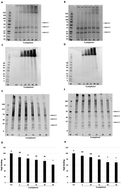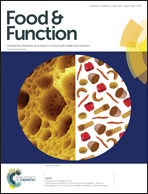Protein-bound Vaccinium fruit polyphenols decrease IgE binding to peanut allergens and RBL-2H3 mast cell degranulation in vitro†
Abstract
Peanut allergy is a worldwide health concern. In this study, the natural binding properties of plant-derived polyphenols to proteins was leveraged to produce stable protein–polyphenol complexes comprised of peanut proteins and cranberry (Vaccinium macrocarpon Ait.) or lowbush blueberry (Vaccinium angustifolium Ait.) pomace polyphenols. Protein-bound and free polyphenols were characterized and quantified by multistep extraction of polyphenols from protein–polyphenol complexes. Immunoblotting was performed with peanut-allergic plasma to determine peanut protein-specific IgE binding to unmodified peanut protein, or to peanut protein–polyphenol complexes. In an allergen model system, RBL-2H3 mast cells were exposed to peanut protein–polyphenol complexes and evaluated for their inhibitory activity on ionomycin-induced degranulation (β-hexosaminidase and histamine). Among the evaluated polyphenolic compounds from protein–polyphenol complex eluates, quercetin, – in aglycone or glycosidic form – was the main phytochemical identified to be covalently bound to peanut proteins. Peanut protein-bound cranberry and blueberry polyphenols significantly decreased IgE binding to peanut proteins at p < 0.05 (38% and 31% decrease, respectively). Sensitized RBL-2H3 cells challenged with antigen and ionomycin in the presence of protein–cranberry and blueberry polyphenol complexes showed a significant (p < 0.05) reduction in histamine and β-hexosaminidase release (histamine: 65.5% and 65.8% decrease; β-hexosaminidase: 60.7% and 45.4% decrease, respectively). The modification of peanut proteins with cranberry or blueberry polyphenols led to the formation of peanut protein–polyphenol complexes with significantly reduced allergenic potential. Future trials are warranted to investigate the immunomodulatory mechanisms of these protein–polyphenol complexes and the role of quercetin in their hypoallergenic potential.


 Please wait while we load your content...
Please wait while we load your content...